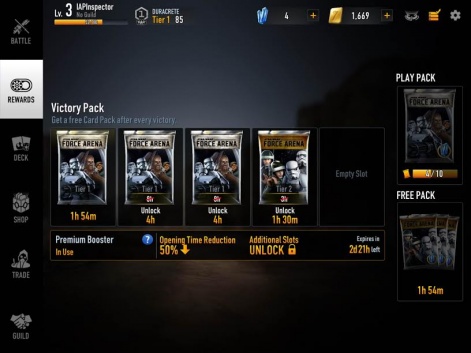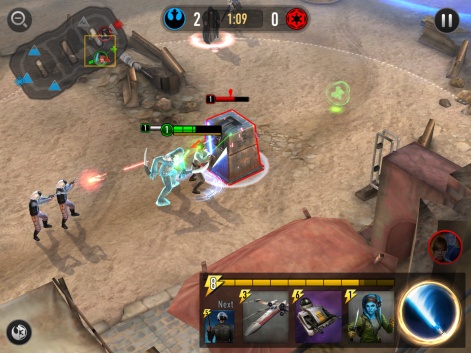Mobile game developers have taken the Star Wars IP in many different directions.
Three of the most prominent examples have been the build-and-battler Star Wars: Commander from Disney Interactive, EA's turn-based RPG Star Wars: Galaxy of Heroes and the ambitious, now-canned action RPG Star Wars: Uprising from Kabam.
Joining them in January 2017 was Netmarble with Star Wars: Force Arena. Inspired by the eSport-friendly MOBA genre, with a hint of Clash Royale, the South Korean developer has managed to find yet another new take on the IP.
To go behind the scenes on development, PocketGamer.biz reached out to Production Director Hong Seo Park.
PocketGamer.biz: How and when did the opportunity arise for Netmarble to develop a Star Wars game?
Hong Seo Park: The global service and success of Marvel Future Fight helped us out a lot.
We feel that as Netmarble Monster proved that it is capable and has enough understanding of large IPs, we were given this great opportunity to take on the Star Wars project.
How did the concept for MOBA-style gameplay emerge and why did you feel that would work well with the franchise?
There are many outstanding battle scenes within the Star Wars movie series. And if you’re a Star Wars fan, you might have dreamt of an iconic battle scene of your own.
We wanted to design our game so that players can collect all of these characters and have them take part in battles.Hong Seo Park
But when we first applied parts of the Star Wars elements into the MOBA-style genre, we felt that something was missing.
Star Wars was not all about just popular characters and villains. There were many more characters that made each series complete.
We definitely wanted to design our game so that players can come in, collect all of these characters and have them take part in battles.
Designing effective real-time PvP for mobile can be difficult. What were the biggest challenges you faced in this area, and how did you overcome them?
Designing battles to always take place within the server for the game to be a proper real-time PvP was our first obstacle. This was surely needed to block out any hacking attempts that may occur within the game.
We also put a lot of effort from the beginning stages into R&D so that our game can be played smoothly under an unstable mobile network.
Unlike the internet on PC, mobile networks can suddenly change and it is very tricky to be ready for these occasions. Even when your Wi-Fi antenna is full, the actual network can be unstable.
Servicing a great game experience in any network condition is still a task for us, but we continue to monitor and improve our battles so that everyone can enjoy the game.
How did you balance the depth and complexity common among MOBAs and accessibility for mobile gamers?
You’ve asked a question on something that we’ve been putting a lot of thought and effort into. As you know, the MOBA genre presents a very high level of gaming.
However, there is a variety of different skill ranges among mobile gamers. There are those who are hardcore gamers and there others who have a low level of understanding when it comes to games.
From the very early stages of our development, we went through various different experiments and tests. We checked the points where our testers were having a hard time and made continuous improvements.
The game now has the depth of a MOBA but welcomes everyone in the real-time PvP battle.
Are you beginning to see a competitive scene developing around the game? Is this something you encourage?
Yes, we do see a competition between the Rebels and the Empire.
We analyse the battle data on a daily basis and do our best so that the battles are fair for everyone.Hong Seo Park
Since players cannot both play on the Rebel side or Empire side, we feel the competition is fiercer as they face opponents.
In order help the balance of the battles that players take part in, we analyse the battle data on a daily basis and do our best so that the battles are fair for everyone.
What did you learn from the soft launch process, and what were the biggest changes you enacted as a result?
It was the two vs. two content. Although the development team thought that two vs. two would be fun, we had a great time testing and proving it through the soft launch process.
As a result, we included the guild feature where players can gather and play together in our global launch.
Although there are more things to be added to the guild feature, there will be more additions and improvements to the game.
What was your thinking in regards to monetisation, particularly the rewards that take time to unlock? Was Clash Royale an inspiration here?
Yes, Clash Royale was one of the inspirations.
In the early stages of development, we had a lot of thoughts on how to effectively present contents to our players.

There were various different options in mind, but we chose the simplest and most friendly way that players are familiar with.
What are the key differences between developing a game with a big franchise like Star Wars and your own IP? How much input did you have from Lucasfilm and Disney?
Fundamentally, there isn’t a huge difference.
Whether developing a game from our own IP or with a big franchise like Star Wars, the understanding and depth of the universe that is being developed is directly related to the quality of the final product.
Since IPs such as Star Wars are well-known, the expectation is extremely high.Hong Seo Park
The only difference would be that since IPs such as Star Wars are well-known, the expectation is extremely high.
In order to meet such expectations and deliver a good result, we have been working closely together with Lucasfilm and Disney from the early stages of development to today.
Everything from visual guidance to features within the game, and even a single piece of text is displayed after agreement on both sides. Lucasfilm and Disney have been giving us great support in the process.
There have been a number of Star Wars games on mobile in recent years. Do you feel additional pressure to compete with these or do you feel the market is big enough for all these titles?
Since the genre of the games are different, we don’t have any added pressure. Rather, we feel that since games including ours are all from the same IP, we are in kind of a cooperation.
Instead of competing with other Star Wars games, we are putting our effort into making Star Wars: Force Arena a better game.
How happy have you been with the global launch? Any surprises?
There are some things that we are happy about, and there are others that we weren’t.
After our global launch, we’ve been closely monitoring player feedback.

While there were various different opinions including many that are helping us to improve, we are thankful for every feedback that players are showing us a lot of interest and are passionate about our game.
What have been the key markets for Star Wars: Force Arena since launch?
Some of the key markets for Star Wars: Force Arena have been the North America region, Europe and the overall Western market where the Star Wars is more popular and strong.
We have a ton of content planned.Hong Seo Park
Even for Asia, where players love competitive content, we expect there will be more interest in the game.
What's next for Star Wars Force Arena?
We want to first work on the basic PvP content.
Some of these may include better matchmaking, balance, rewards, point systems and a better overall environment to play the game together.
Of course we have a ton of content planned in our next step. Fun features including new characters, new modes and guild content are all being prepared, so hold tight and be ready.
















